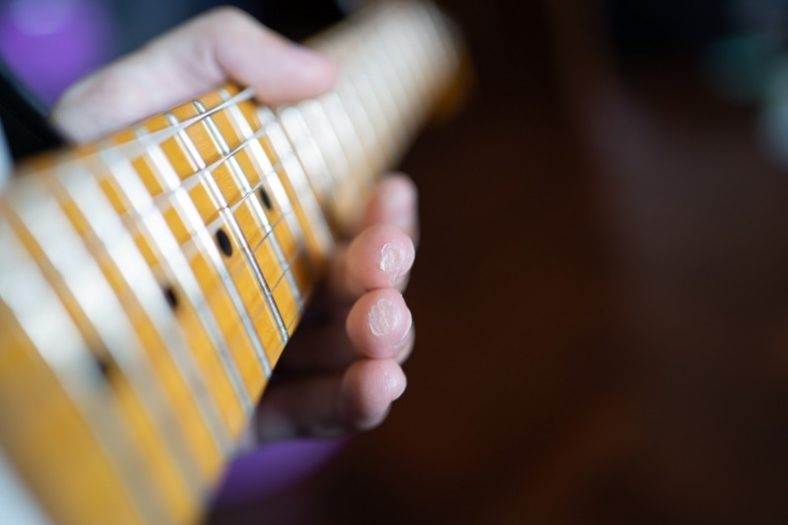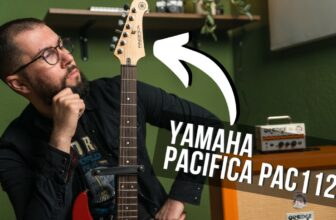Guitar Calluses (All Your Questions Answered)

Guitar calluses are thick and hardened areas of the skin on your fingertips, which form as a result of friction and pressure from pressing on the strings on the fretboard.
There are a lot of questions and concerns about guitar calluses. This article will help you understand and know more about the topic. It will also help with the knowledge of how to properly build up your calluses while avoiding injuries.
The fingertips in contact with the strings start chipping off due to friction and over time the skin adapts to this abrasion. This results in the hardening of the skin in that area to adapt to the pain and in turn results in guitar calluses.
Generally, playing guitar is difficult for beginners as it can be sore to press on the strings for an extended period. Over time, guitar calluses develop in response to deal with this, which then desensitizes the fingers from this pain.
Guitar calluses, as a result, provide painless sessions and longer ones too. Despite the unattractive name and unpleasant sight, guitar calluses are beneficial.
Contents
What are the benefits of having calluses?
One of the primary advantages of having guitar calluses is the ease with which you can play.
Because the skin on the tips of your fingers is soft when you first start playing guitar, it might be difficult to play properly.
Guitar calluses harden the fingers, making it simpler to play with less discomfort. This firm skin also aids with longer practice routines by reducing pain, which is one of the main reasons why novices are unable to practice for lengthy periods at once.
In addition to reduced finger pain and longer practice sessions, guitar calluses also help with more defined and accurate hammer-ons and pull-offs, which are crucial in developing your unique sound. Similarly, it also helps in bending and vibratos which makes your playing take a whole new level.
How To Build Them Up?
There are a few options that can help you build guitar calluses. This does, however, take time and patience. You don’t want to risk an injury, but with the suggestions outlined below, you can quickly develop calluses.
Try to practice frequently but for short periods to begin developing guitar calluses. This is because if you put too much pressure on your skin by playing for prolonged periods, you may end up chipping too much skin and might end up going to a doctor.
This is the worst case scenario, because your skin isn’t acclimated to it, it can cause bleeding if it gets severe. Shorter practice routines will help give you enough time for your fingers to heal a little before you start playing again.
The next piece of advice is to use thick gauged strings rather than lighter gauged strings. This is because playing on heavier strings requires a lot more effort. Thicker strings are also bigger, making your fingers work even harder, which adds up.
Another excellent suggestion that many people overlook is to replace nylon strings with steel or acoustic strings. Nylon strings are often much softer than acoustic or steel strings, taking more time to develop guitar calluses.
Another helpful suggestion is to dry your fingertips using drying alcohol, which will help the skin shed even faster. As a result, your body will respond and adapt more quickly.
Last but not least, while practicing, try using a higher action on your guitar. This implies that your strings will be higher on your fretboard, taking extra effort to make your guitar sound properly. This will increase the likelihood of developing guitar calluses much more quickly than usual.
How long does it take to develop them?
Guitar calluses take about a month to develop on average, although their development is mostly dependent on you and how frequently you practice.
The more you practice, the faster your body adjusts and your fingertips’ skin becomes harder. This is because your body will respond and adapt to the pain and skin loss caused by the strings’ friction.
Several less significant factors affect this process, such as the method you use when playing because if you alter your technique frequently, calluses will develop faster.
This also applies to the genre of music you play; if you only play country music, you’re more likely to take longer because you’ll be using open chords and making chord changes less frequently.
Another thing to consider is the type of guitar you use. Because the type of guitar you have will affect the strings and action you have. All of these aspects are taken into account as to when and how soon you get calluses.
Another element to consider is the hardness of your skin before you begin playing, as calluses will take longer to form if your skin is already hard.
How to reduce finger pain?
If you start having issues and wish to reduce the pain you experience while playing, you should first opt for lighter gauge strings and get your guitar’s action lowered.
This will assist and make playing the guitar simpler, hence reducing pain.
Following that, you should look for nylon string or classical guitars to play and practice on. This is because nylon strings are softer and easier to play with. They also have significantly less tension on the guitar neck, making them a viable solution.
You could also shorten the duration of your practice sessions. This will allow you ample time to recover and, because you will be spending less time on the strings, it will also help with the pain.
How to treat your fingers if they are sore?
There are several numbing ointments on the market that you can apply on your fingertips. If the pain is unbearable, it is always a good idea to seek medical advice.
Using apple cider vinegar on your fingertips is another approach to relieve the pain. This is because apple cider vinegar promotes healing, and if you use it in between practicing or playing, it will aid in the healing of your fingertips.
Applying a cold compress or bandage to your finger is another option. This will aid in the relief of discomfort and swelling in your finger, as well as the mending of your fingertips, allowing you to practice more frequently.
Super glue is another option for dealing with discomfort, albeit it is not the ideal option and should be avoided if at all feasible. This is not a recommended method, although it may be necessary for some emergencies.
Lastly, try using tattoo healing products. Tattoo ointments are a good alternative as they are based on healing damaged skin, aid in peeling quicker, and recovering the damaged skin much faster.
Do they go away eventually?
The guitar calluses you’ve built and spent so much effort on, in certain situations, fade away just as quickly as they appeared.
This is because, like any other muscle or skin, your fingertips heal and shed. This implies that the hard skin you developed will continue to repair and shed, eventually causing your guitar calluses to fade away.
Think of guitar calluses as any other muscle group, if you start going to the gym, pain is a given in the beginning but becomes less painful with time to eventually build your muscle. However, if you stop going to the gym, eventually that muscle will slowly revert back.
Summary
Finally, guitar calluses are seen as a badge of honor by guitarists, who proudly display them. They are really beneficial since they allow you to play and practice for much longer periods without having to take breaks due to finger pain.
I’ve provided you with tools and tips to help you create them more quickly and care for them properly. We’ve also addressed the most frequently asked questions about the subject. Remember that knowing everything won’t benefit you unless you put in the effort.





